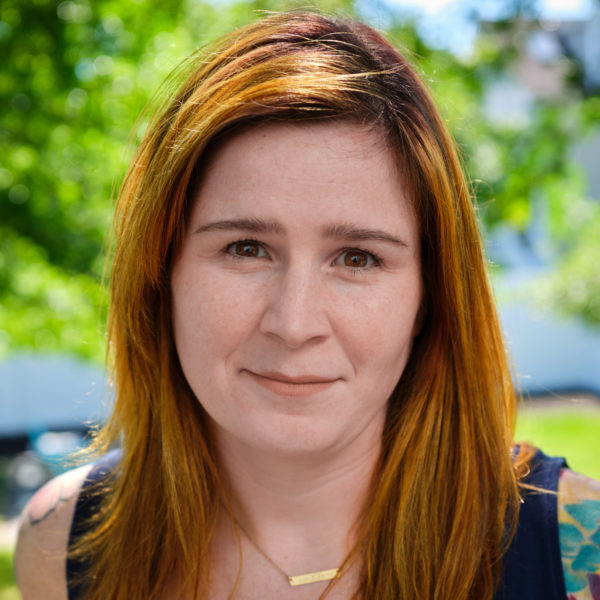Advertisement
How A Day Of Peaceful Protest Turned To Hours Of Unrest In Boston
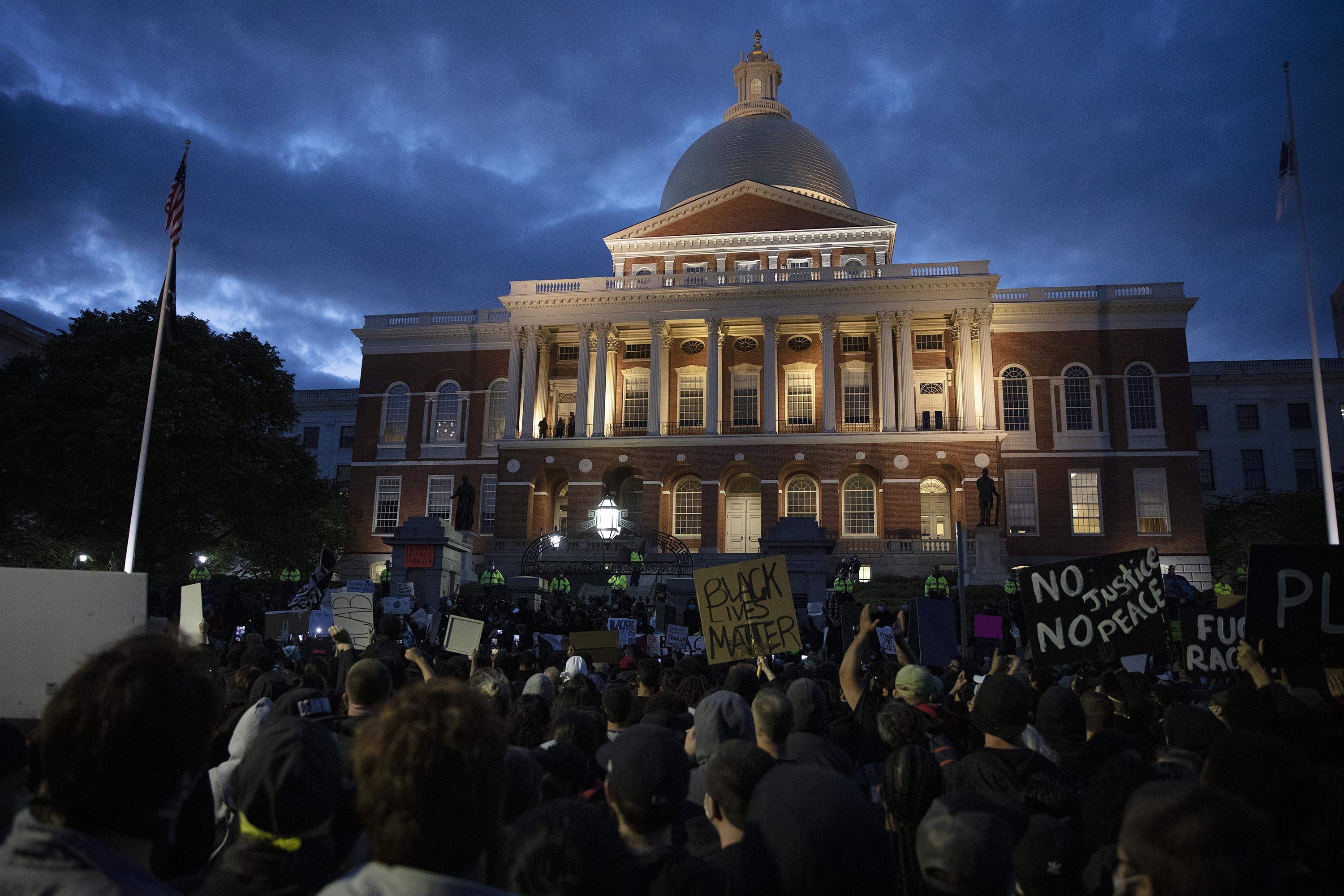
By all accounts, the massive march that began in Roxbury’s Nubian Square Sunday evening was peaceful and resolute, as thousands of protesters responded to the death of George Floyd and called for an end to police violence.
But shortly after the official event finished at the State House around 9 p.m., something changed. A day of peaceful protest, solidarity and calls for justice shifted, after many protesters had left, into a night of confrontations: police used tear gas against the crowd, some people destroyed property and looted stores. Fifty-three people were arrested. At least one state lawmaker is now calling for an investigation into how law enforcement handled the situation.
Accounts from more than a dozen protesters, several reporters and photographers at the scene, law enforcement radio dispatches, tweets, video and elected officials’ statements after the fact begin to reveal a picture of what happened.
As the march ended, protesters near Boston Common say the trouble was sparked by a confluence of factors: Many people were stranded after the MBTA shut down several nearby stations. Some protesters described feeling penned in by lines of law enforcement officers blocking streets as demonstrators sought to leave. According to video and witness accounts, police cruisers drove down crowded streets near the State House, coming close to hitting people. Long lines of baton- and bike-wielding officers pushed people out of the area.
Police, meanwhile, say it was a contingent of demonstrators who escalated tensions, throwing water bottles and bricks, burning and damaging 21 cruisers and sending at least nine officers to the hospital with injuries not considered life-threatening.
“Unfortunately individuals showed up not with a peaceful intent on mind, but with being disruptive,” Police Commissioner William Gross said at a press conference Monday.
Gross said Wednesday that the department was planning for a peaceful protest of 2,000 — but 20,000 people showed up.
"And we kept the city from burning," he said. "We were attacked, eventually shot at ... but paramount on our mind was the peaceful protesting."
Boston police did not respond to questions over the last two days seeking more information about its officers’ actions.
The Boston Police Patrolmen’s Union didn’t respond to calls either. It did, however, in separate letters condemning the responses of elected officials, defend officers. The union said protesters attacked police and that officers showed “enormous restraint” amid “violence against the police, the likes of which this city has not seen in a generation.”
Advertisement
Organizers of the march this week said they weren’t ready to comment.
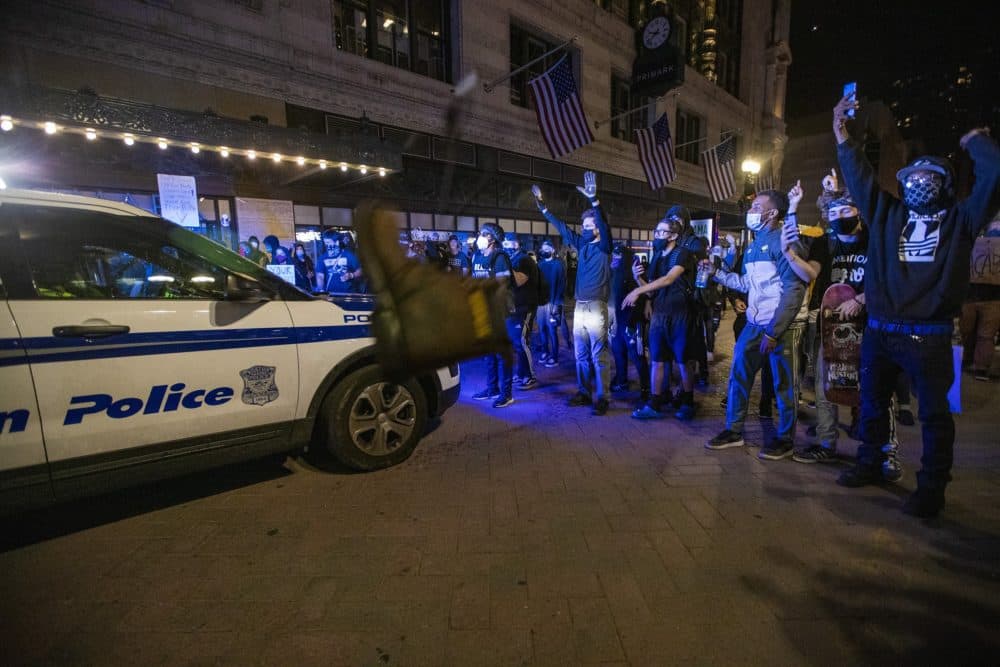
But demonstrators who spoke to WBUR say a turning point seemed to come at around 9:15 p.m. As the formal protest drew to a close, many marchers sprawled across the Common and couldn’t hear the organizers say goodnight from the State House steps.
For marchers like Michelle Dugan, 31, the ending of the event was unclear. She didn’t hear any announcements from the organizers or police. Still, she was ready to head home. She went straight for the Park Street T station to catch the Green Line back to Brighton. She was waiting on the platform with 60 or 70 other people when she says a T employee told everyone to leave because the station was closing.
People poured back onto the street, Dugan explained. But she ignored the instructions to leave. She jumped on a train just rolling into the station.
“The cops say, ‘OK time to go’ and then immediately shut down all the transit and block the roads so people can’t go,” she said, noting that this has been a problem for protesters in other cities that shut transit down completely. “I don’t know what the logic is behind it.”
An announcement that nearby stations were shutting down came via Twitter at 9:22 p.m., about 20 minutes after the march ended. On Wednesday night, the T's General Manager Steve Poftak sent out a nine-paragraph statement defending the closures. Poftak said the transit police commander on Sunday closed the stations believing "outside activity posed a danger" amid a "very unsettled scene and a fluid situation."
"There are no policies or directives to keep people in one place," Poftak said in the statement. "In fact, our planning includes measures to safely facilitate the movement of large crowds."
Above ground on Sunday night, demonstrators said they began to see more police arriving on foot, by bike and in vehicles — many more than they had seen along the march route.
Jasmine Webb, 35, was on Boston Common not far from the Boylston Street T station when she saw a line of helmeted and baton-holding officers dressed in black run past her. It was startling, she said, especially since she saw few officers during the march itself.
“It would have been nice if they marched with the people to say, ‘Hey, we get it, too. We don’t like this corrupt stuff that’s going on within our system. We stand with you,’ ” she said. “But instead, they show up at the end when it’s time to lay down the law. And that’s not what policing is all about.”
To Webb, the sight of these helmet-clad officers was like a militia arriving on the streets of her city.
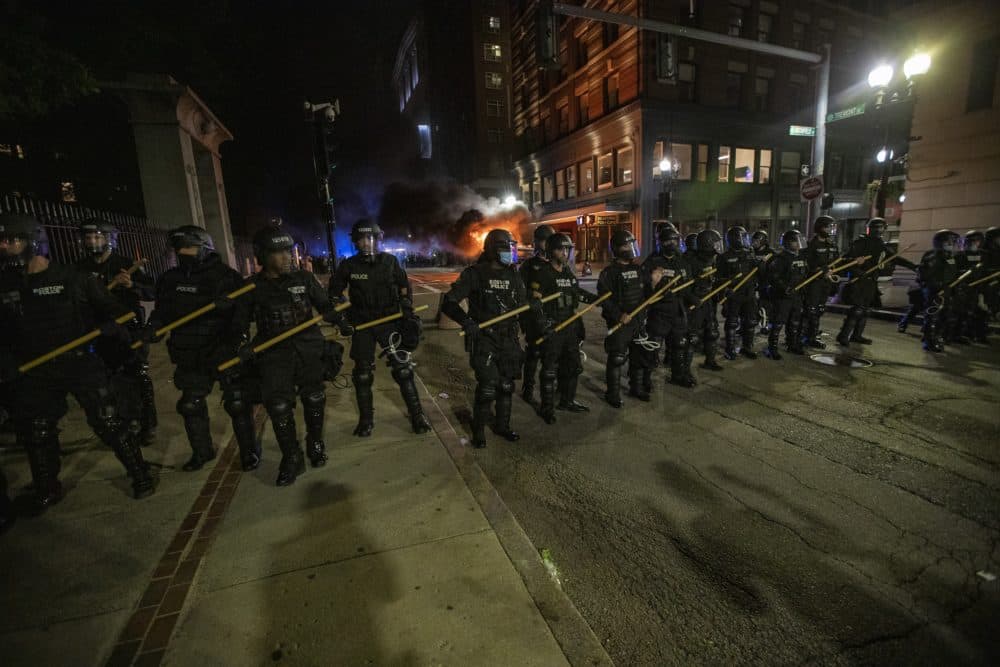
Protesters were still mingling at 9:25 p.m. when police cruisers drove through Beacon Street, lights and sirens on. One police van, according to a WBUR reporter at the scene, stopped just before hitting a group of people.
“I saw people literally jumping out of the way," Preyel Patel, of Somerville, said. Patel said she didn't see anyone injured.
Some people started throwing bottles at the cruiser and over the fence at the State House. Other protesters knelt in the road with their hands up.
Further south in the Common, near the Park Street T Station on Tremont Street, tensions were rising, too. People pelted a group of bicycle police with bottles. Someone threw a large traffic cone that appeared to hurt an officer.
Officers, as they had at times along the parade route, withstood insults and pointed fingers from demonstrators. Several protesters got in the faces of police, who used batons, pepper spray and tear gas to push them back.
Lance Jackson, 24, said he tried to dissuade protesters from being aggressive toward officers. He said police will abuse their power if given a reason.
“Do not provoke them, so that way we don’t get hurt,” he recalled telling others. “Because the first people they’re going to shoot at is black people.”
He watched a crowd surround an abandoned cruiser.
“Either they were passionate protesters or they were just there to see destruction happen and were there for the wrong reasons,” he said. “They kept beating on this cop car. And eventually it caught fire. And then eventually exploded.”
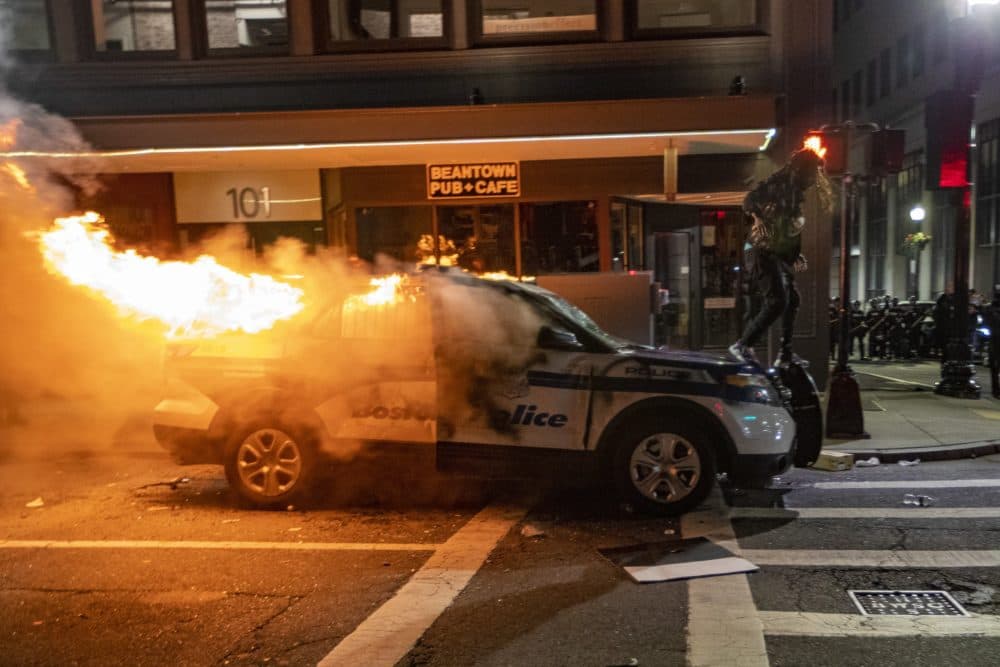
Brenna Miller, 23, of South Boston, had parked her car near South Station and began walking down Winter Street after the march ended, hoping to cut through Downtown Crossing. The mood was changing as she walked, she said.
"I saw a bunch of police running past me in riot gear. Everybody started picking up their pace. The energy was kind of shifting," she said.
Police had barricaded one end of Winter Street, forming a semi-circle. Miller said it felt impossible to get out.
“I was just trying to get back to my car … and I had no options,” she said.
Some of the people in the crowd threw water bottles, as Miller said she and others screamed at them to stop. She joined a line in front of the police as a "body barrier," in an attempt to calm things down.
Soon, more police began arriving in cruisers and on bikes. They walked into the crowd, Miller said, pushing the line of protesters back.
By 9:17 p.m., police hit her and others with pepper spray.
Rohan Mudgal, 23, said he watched the police surround another group of protesters nearby and try to separate them. That fired up the crowd even more, he said.
“I really think that the whole crowd was on edge throughout the night but remained almost entirely peaceful, until just that one spark kind of propagated and ignited the crowd,” Mudgal said. “At that point, I think, people started going wild.”
Over the radio, Boston police said they needed help from all available officers not already on scene, according to dispatch reports from Broadcastify.com.
“Everyone not assigned, go to Downtown Crossing,” said someone on the a dispatch call around 9:15 p.m. “They’re screaming for help.”
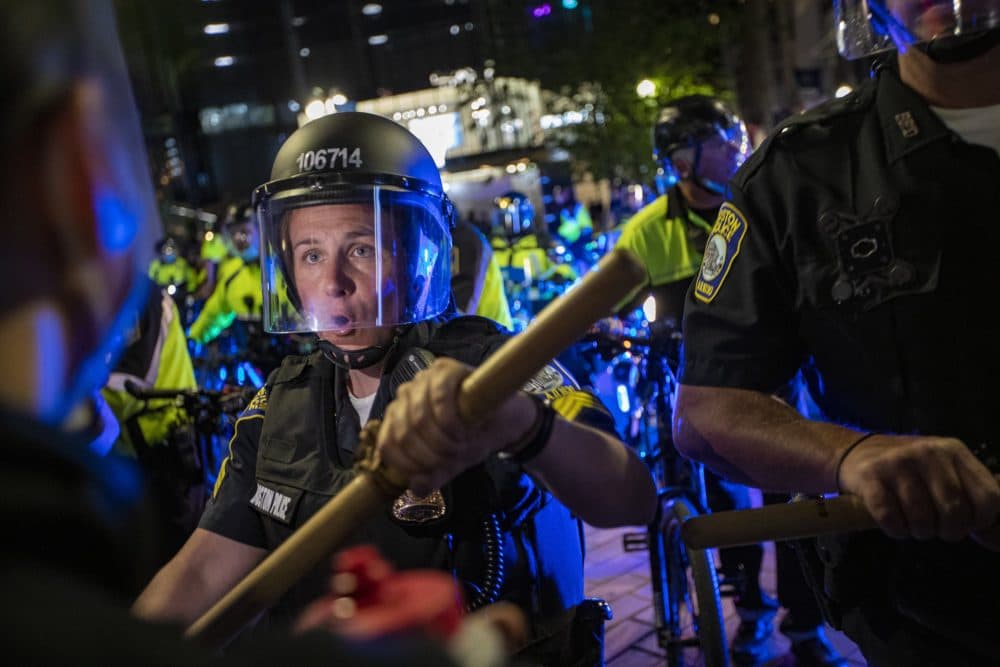
Around 9:30 p.m., Boston police tweeted for the first time about protesters throwing rocks and bricks at officers. They followed this with two other tweets telling people to go home.
By 9:33 p.m., radio dispatches with the state police detail the Massachusetts National Guard’s deployment. Officers asked how many troops there would be, and how soon.
As the night drew on, the situation grew more tense. State police said in a later statement that they shot "pepper ball projectiles" at a group of people near the State House, when the group began surrounding and striking a transit police cruiser with an officer behind the wheel. That officer was ultimately able to drive away. In several areas, including Newbury Street and Downtown Crossing, people smashed windows and took merchandise from stores.
Just before 10 p.m., Boston police tweeted that protesters had “surrendered the moral high ground.”
Police and protesters remained on the streets for hours. People smashed the windows and glass doors of convenience stores, jewelry shops and other businesses, leaving them wide open for people to walk out with whatever they wanted — even lottery tickets.
Many of those arrested were arraigned Monday during phone proceedings, as the state’s courts remain closed for most business because of the coronavirus pandemic. The charges ranged from disorderly conduct and malicious property damage to breaking and entering and possession of a loaded weapon without a license.
The most serious charges were against 37-year-old John Boampong, of Dorchester. Police say he was behind the wheel of a car from which 10 shots were fired on officers around 3 a.m. He was charged with more than 20 counts of assault with intent to murder, failure to stop for police and carrying a loaded firearm without a license. He pleaded not guilty and is being held without bail.
Most of the protesters WBUR spoke to blamed police for escalating tensions. Not everyone had the same experience, though. Marlene Boyette, 37, spent almost an hour after the march in the Common. She saw cruisers drive through the crowd along Beacon Street, but slowly. She saw protesters throw water onto the cars in response.
“All things considered, I feel like the police were very, very, very chill for a very long time after the march ended,” she said. “At no point did I feel like my safety was in jeopardy. I wasn’t scared. And people pretty much were peaceful. People were not going crazy at that point.”
It was only when she got in the car with her friends to head back to Jamaica Plain, and one of them checked the news on a cellphone, that they saw conflicts had begun.
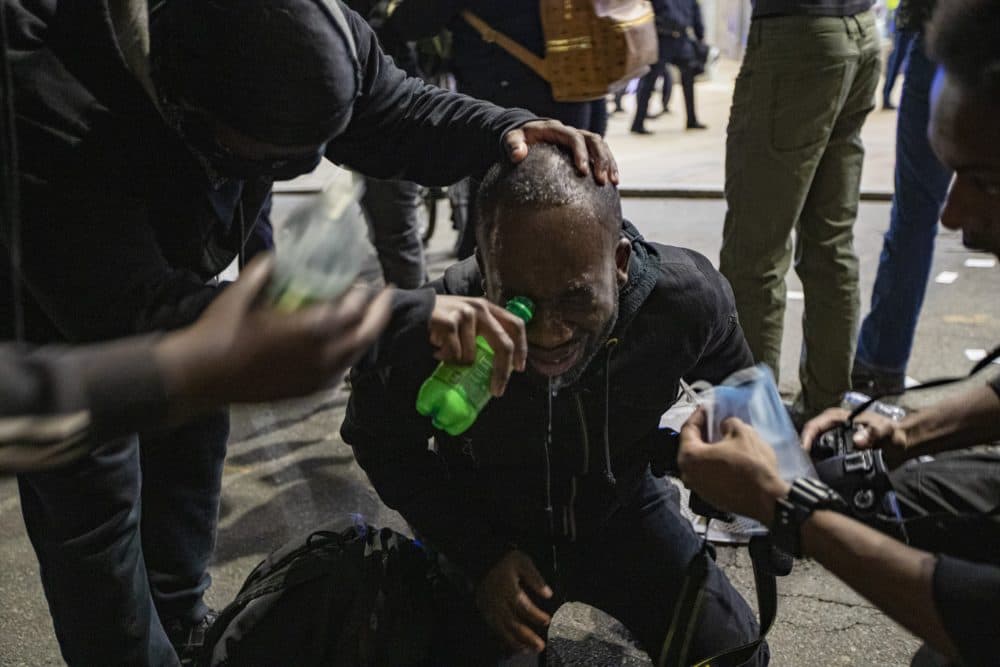
Many questions still remain about whether police could have handled the situation differently or better, and who and what sparked the destruction of property and attacks on police.
State Sen. Jamie Eldridge, a member of the Legislature's Judiciary Committee, is calling on the governor to have an independent investigator look into how the demonstration was handled, rather than the state.
"I do not think it should be done, respectfully, by the [state’s] Executive Office of Public Safety [and Security]," he said. "I think it should be done by a truly independent investigator."
The FBI is also investigating. The agency's Boston office has asked people to come forward with information about "violent instigators who are exploiting legitimate, peaceful protests." Massachusetts U.S. Attorney Andrew Lelling promised federal charges, if necessary, against those who looted stores, attacked police or torched cruisers.
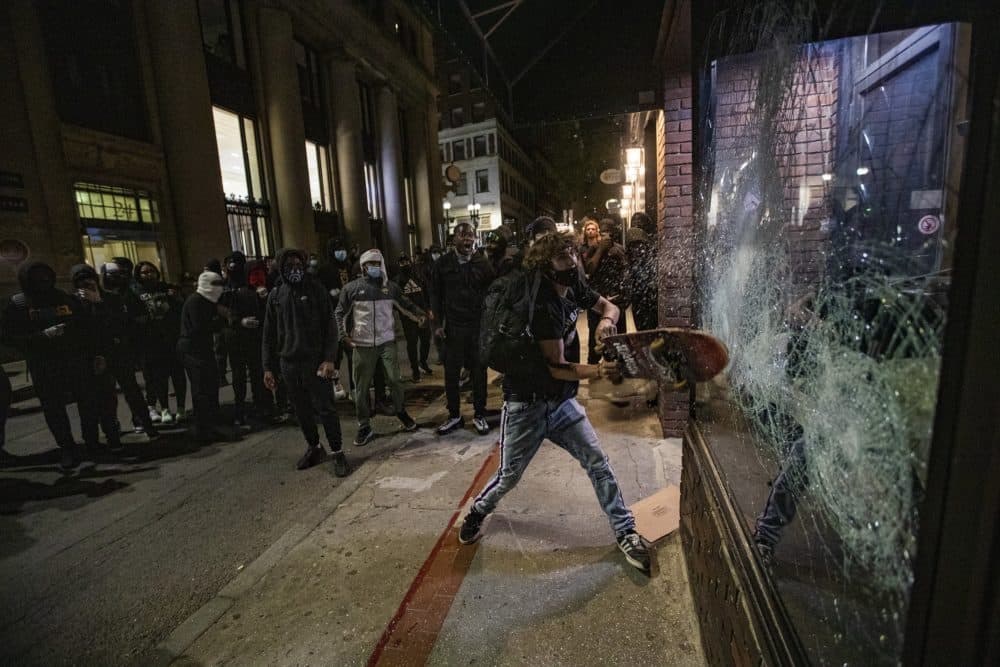
No one WBUR talked to condoned the rock and bottle throwing, property damage or other crimes that occurred. Several people interviewed wished the focus could have been on the moments of kindness during the march — those who handed out masks and hand sanitizer. A powerful moment when protesters took a knee in front of the State House. The diversity of the people who participated in the march itself. They said repeatedly that it didn’t have to end this way.
“I deplore the violence and the looting that happened afterward,” marcher Lawrence Wang, 32, said. “But I want to be very clear. The police made these conditions possible. In fact, they inflamed the tensions in the first place.”
There have now been at least three more protests and vigils in Boston since Sunday, including a large gathering in Franklin Park Tuesday night. All have avoided the kinds of major conflicts seen on Sunday. Demonstrations against police brutality and in honor of those killed by police are expected to continue.
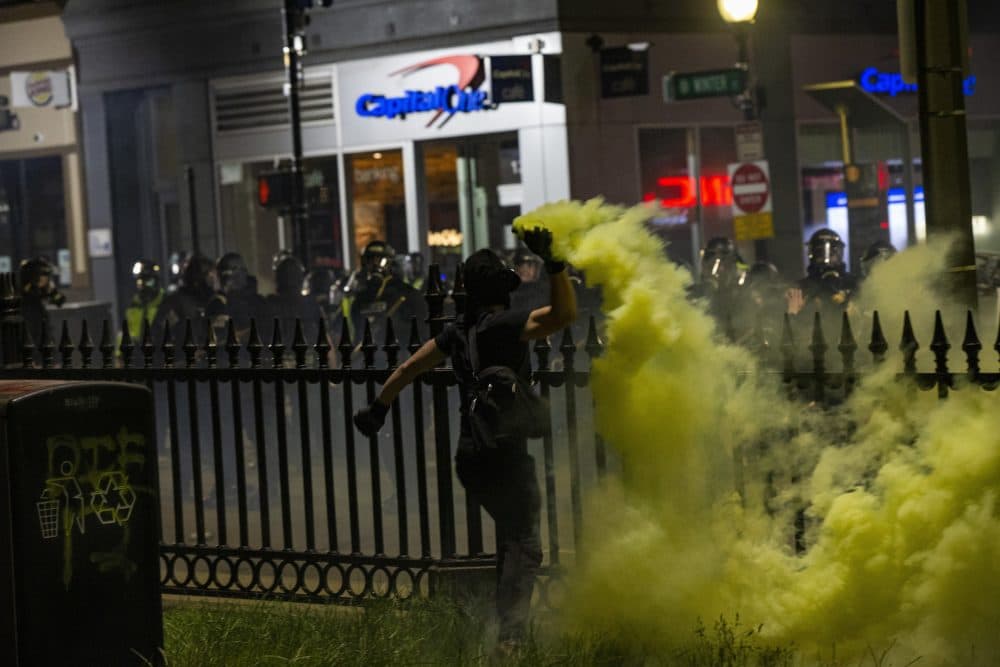
This story was reported by WBUR's Ally Jarmanning, Meghan Kelly, Bruce Gellerman, Simón Rios, Adrian Ma, Jesse Costa, Robin Lubbock, Christine Willmsen, Deborah Becker and Shannon Dooling. Ally Jarmanning wrote the story.
